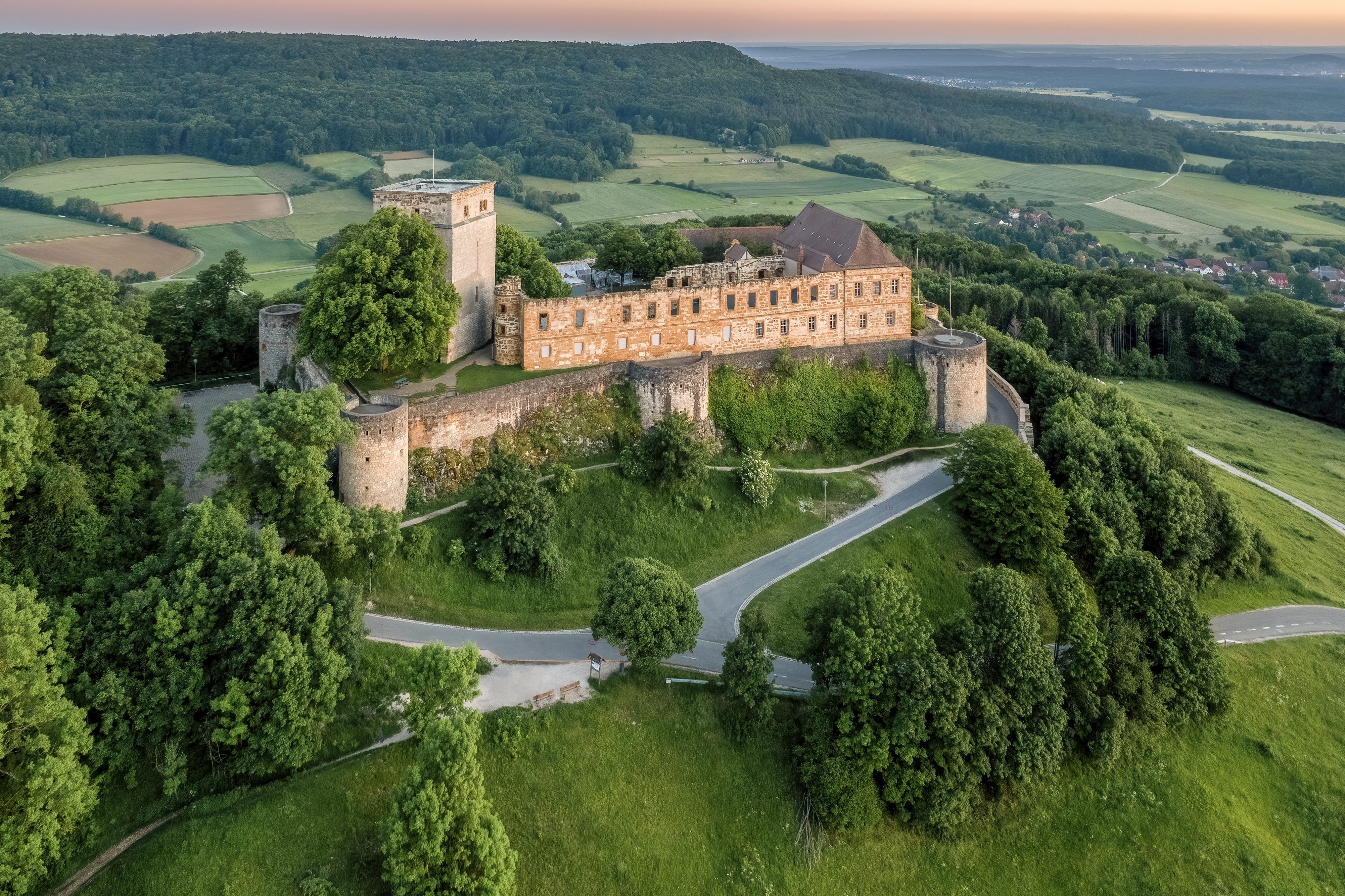|
Giechburg
The Giechburg is a partly reconstructed hilltop castle located within the town of Scheßlitz in Upper Franconia, Bavaria, Germany. The castle has given its name to a constituent community within the town. History Archeological evidence indicates that this hilltop was fortified as far back as Neolithic times. The castle enters written history in 1125, and its possession thereafter is marked by a succession of wills and bequest documents, punctuated by at least one forcible transfer in 1142. The castle entered the possession of the prince-bishops of Bamberg in 1390, and its history thereafter is closely allied to the bishopric and the city of Bamberg. From 1421 until 1459, a period of disorder associated with the Hussites in nearby Bohemia, the castle was further fortified and strengthened until it took its final form as a mature medieval castle with a keep. As gunpowder warfare matured, the Giechburg was no longer useful as a strongpoint. It was adaptively reused by the ... [...More Info...] [...Related Items...] OR: [Wikipedia] [Google] [Baidu] |
Scheßlitz
Scheßlitz (or ''Schesslitz'') is a German town in the Upper Franconian district of Bamberg and lies on the rise to the Franconian Switzerland on the A 70 between Bamberg and Bayreuth, lying 14 km northeast of the former. Geography The town is surrounded by the following hills: :Stammberg (559 m) :Giechburg (530 m) :Gügel (515 m) :Kulm (553 m) :Heidenstein (577 m) :Rabenstein (572 m) :Würgauer Höhe (518 m) :Reisberg (554 m) :Roter Stein (518 m) :Wattendorfer Höhe (555 m) :Hohe Metze (577 m) This basin's sheltered setting with roads that come together from Heiligenstadt, Hollfeld, Weismain, Bad Staffelstein and Zapfendorf favoured settlement in prehistoric times. Constituent communities Scheßlitz's main town and namesake centre is by far the biggest of its ''Ortsteile'' with a population of 2,548. The town furthermore has these outlying centres, each given here with its own population figure: (as of 31 March/4 April 2005) The amalgamation of these '' Stadtteile' ... [...More Info...] [...Related Items...] OR: [Wikipedia] [Google] [Baidu] |
Giechburg Luftaufnahme-20210614-RM-212813
The Giechburg is a partly reconstructed hilltop castle located within the town of Scheßlitz in Upper Franconia, Bavaria, Germany. The castle has given its name to a constituent community within the town. History Archeological evidence indicates that this hilltop was fortified as far back as Neolithic times. The castle enters written history in 1125, and its possession thereafter is marked by a succession of wills and bequest documents, punctuated by at least one forcible transfer in 1142. The castle entered the possession of the prince-bishops of Bamberg in 1390, and its history thereafter is closely allied to the bishopric and the city of Bamberg. From 1421 until 1459, a period of disorder associated with the Hussites in nearby Bohemia, the castle was further fortified and strengthened until it took its final form as a mature medieval castle with a keep. As gunpowder warfare matured, the Giechburg was no longer useful as a strongpoint. It was adaptively reused by the p ... [...More Info...] [...Related Items...] OR: [Wikipedia] [Google] [Baidu] |
Prince-Bishopric Of Bamberg
The Prince-Bishopric of Bamberg (german: Hochstift Bamberg) was an ecclesiastical State of the Holy Roman Empire. It goes back to the Roman Catholic Diocese of Bamberg established at the 1007 synod in Frankfurt, at the behest of King Henry II to further expand the spread of Christianity in the Franconian lands. The bishops obtained the status of Imperial immediacy about 1245 and ruled their estates as Prince-bishops until they were subsumed to the Electorate of Bavaria in the course of the German Mediatisation in 1802. State The Bishops of Bamberg received the princely title by Emperor Frederick II of Hohenstaufen before his deposition by Pope Innocent IV in 1245, whereby the diocese became an Imperial state, covering large parts of the current Bavarian region of Franconia ("Main Franconia"). Part of the Franconian Circle (territories grouped together within the Holy Roman Empire for defensive purposes) from 1500 onwards, the Bamberg territory was bordered, among others, ... [...More Info...] [...Related Items...] OR: [Wikipedia] [Google] [Baidu] |
Castles In Bavaria
Numerous castles are found in the German state of Bavaria. These buildings, some of which have a history of over 1,000 years, were the setting for historical events, domains of famous personalities, and are still imposing structures to this day. This list encompasses castles described in German as ''Burg'' (castle), ''Festung'' (fort/fortress), ''Schloss'' (manor house) and ''Palais''/''Palast'' (palace). Many German castles after the Middle Ages were built mainly as royal or noble residences rather than as fortified buildings. Regierungsbezirk Oberbayern Altötting # Burghausen Castle ('' in German'') # Castle Tuessling ('' in German'') Bad Tölz-Wolfratshausen # Seeburg (Münsing) # Schloss Hohenburg # Hohenburg (Lenggries) (ruin) Berchtesgadener Land # Berchtesgaden Castle ('' de'') # Gruttenstein Castle ('' de'') # Burgruine Karlstein ('' de'') # Castle Laufen # Marzoll Palace ('' de'') # Raschenberg Castle ('' de'') # Staufeneck Castle ('' de'') Dac ... [...More Info...] [...Related Items...] OR: [Wikipedia] [Google] [Baidu] |


